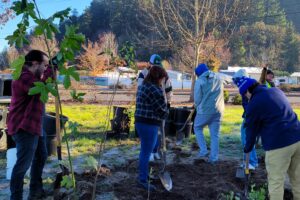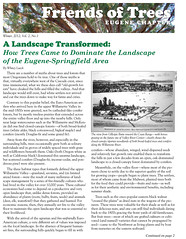Tag: Springfield
Returning to a Natural Area in Springfield
Can I get a refill?
Next month, volunteers will be planting trees, shrubs, and understory near a major intersection on the Bob Straub Parkway in Springfield. But they won’t be starting from scratch—this location has already been the site for four planting events in the past six years. You’ve heard us say it before at Friends of Trees, we don’t just plant and walk away. But what exactly does that mean? It means post-planting care, stewardship training, and in the case of many natural area plantings like this one, it means infill planting.
Infilling is sort of like refilling, not that this site is empty. Thanks to enthusiastic past volunteers who planted it and neighbors of the planting site who have protected it, it’s already a beautiful spot.
“This is one of our most successful Green Space plantings,” says Eugene Director Erik Burke. “It’s in the floodplain, and it has really good soil. Overall, things are growing really well.”
That doesn’t mean that the site isn’t worthy of some replanting. At natural area plantings like this one, we plant in pods that have multiple levels: trees, shrubs, and herbaceous understory with things like milkweed and camas. At the Bob Straub planting site, a few trees need to be replaced and some of the shrubs and flowers could use some support.

“We really want to create a rich, robust planting area,” Erik says. “It’s so satisfying to create these dense clusters of plants.”
We plant these pods similar to the Miyawaki Method, which aims to mimic how a forest would rebuild itself if people stepped away. It’s all about establishing a community of trees and plants, which is fitting because a community of people plant it, care for it, and benefit from it.
“Like with all of our plantings, it’s important to make sure that they have a lasting impact,” Erik says. “That’s why we return.”
Eugene & Springfield winter newsletter

“Another beautiful winter is nearing its end. Alder catkins are releasing their pollen. Across the city, trees’ leafless forms stand out against winter skies. I love this time of year and the anticipation of spring. The bustle of the holidays and the typically wet months of November and December are behind us, as is our coldest month of January, and one can feel the sunlight strengthening. The leaves of camas and other bulbs are rising from the ground, and buds are swelling.
“I believe 2012 will be an especially productive year for Friends of Trees, and I am grateful to all who helped build Eugene Tree Foundation and bring Friends of Trees to where it is today. …

